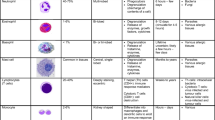Summary
C3H/He mice were found to be low responders in the contact sensitivity response to ABA. Intravenous injection of ABA-coupled syngeneic spleen cells induced hapten-specific Ts in C3H/He mice. These cells were Ts1 because they acted on the inductive phase of the contact sensitivity. They could suppress the contact sensitivity in H-2-compatible CBA mice which were known to be high responders to ABA. Using in vivo and in vitro systems for the induction of Ts, it was shown that I-A−J-J+Thy-1− adherent cells were necessary as APC for the induction of Ts1.
Similar content being viewed by others
References
Schwartz, R.H., Yano, A., Paul, W.E.: Interactions between antigen-presenting cells and primed T lymphocytes: an assessment of Ir gene expression in the antigen-presenting cell. Immunol. Rev.40: 153 (1978).
Unanue, E.R.: The regulation of lymphocyte functions by the macrophage. Immunol. Rev.40: 227 (1978).
Cowing, C.; Pincus, S.H.; Sachs, D.H.; Dickler, H.B.: A subpopulation of adherent accessory cells bearing both I-A and I-E or C subregion is required for antigen-specific murine T lymphocyte proliferation. J. Immun.121: 1680 (1978).
Nepom, J.T.; Benacerraf, B.; Germain, R.N.: Analysis of Ir gene function using monoclonal antibodies: independent regulation of GAT and GLPhe T cell responses by I-A and I-E subregion products on a single accessory cell population. J. Immun.127: 31 (1981).
Claman, H.N.; Miller, S.D.; Sy, M.-S.; Moorhead, J.W.: Suppressive mechanisms involving sensitization and tolerance in contact allergy. Immunol. Rev.50: 105 (1980).
Greene, M.I.; Benacerraf, B.: Studies on hapten-specific T cell immunity and suppression. Immunol. Rev.50: 163 (1980).
Sherr, D.H.; Heghinian, K.M.; Benacerraf, B.; Dorf, M.E.: Imnune suppression in vivo with antigen-modified syngeneic cells. IV. Requirement for Ia+ adherent cells for induction. J. Immun.124: 1389 (1980).
Zembala, M.; Asherson, G.L.; Colizzi, V.: Hapten-specific T suppressor factor recognizes both hapten and I-J region products on haptenized spleen cells. Nature297: 411 (1982).
Minami, M.; Honji, N.; Dorf, M.E.: Mechanism responsible for the induction of I-J restrictions on Ts3 suppressor cells. J. exp. Med.156: 1502 (1982).
Germain, R.N.; Benacerraf, B.: A single major pathway of T-lymphocyte interactions in antigen-specific immune suppression. Scand. J. Immunol.13: 1 (1981).
Takaoki, M.; Sy, M.-S.; Tominaga, A.; Lowy, A.; Tsurufji, M.; Finberg, R.; Benacerraf, B.; Greene, M.I.: I-J-restricted interactions in the generation of azobenzenearsonate-specific suppressor T cells. J. exp. Med.156: 1325 (1982).
Lowy, A.; Tominaga, A.; Drebin, J.A.; Takaoki, M.; Benacerraf, B.; Greene, M.I.: Identification of an I-J+ antigen-presenting cell required for third order suppressor cell activation. J. exp. Med.157: 353 (1983).
Nakamura, R.M.; Tanaka, H.; Tokunaga, T.: In vitro induction of suppressor T cells in delayed-type hypersensitivity to BCG and an essential role of I-J positive accessory cells. Immunol. Lett.4: 295 (1982).
Nakamura, R.M.; Nakamura, Y.; Nagayama, A.; Tokunaga, T.: I-J positive cloned macrophages as accessory cells for the induction of suppressor T cells in vitro. Immunol. Res.5: 106–116 (1986).
Tada, T.; Okumara, K.: The role of antigen-specific T cell factors in the immune response. Adv. Immunol.28: 1 (1979).
Minami, M.; Furusawa, S.; Dorf, M.E.: I-J restrictions on the activation and interaction of parental and Fl-derived Ts3 suppressor cells. J. exp. Med.156: 465 (1982).
Dorf, M.E.; Benacerraf, B.: I-J as a restriction element in the suppressor T cell system. Immunol. Rev.83: 23 (1985).
Usui, M.; Aoki, I.; Sunshine, G.H.; Dorf, M.E.: A role for macrophages in suppressor cell induction. J. Immun.132: 1728 (1984).
Noma, T.; Usui, M.; Dorf, M.E.: Characterization of the accessory cells involved in suppressor T cell induction. J. Immun.134: 1374 (1985).
Habu, S.; Yamauchi, K.; Gershon, R.K.; Murphy, D.B.: A non-T: non-B cell bears I-A, I-E, I-J, and T1a (Qa-1?) determinants. Immunogenetics13: 215 (1981).
Murphy, D.B.; Horowitz, M.C.; Homer, R.J.; Flood, P.M.: Genetic, serological and functional analysis of I-J molecules. Immunol. Rev.83: 79 (1985).
Asano, Y.; Okumura, K.; Tada, T.: Ia antigens on antigen-presenting cells do not carry the same Ia specificities as detected on suppressor and helper T cells. Scand. J. Immunol.13: 353 (1981).
Murphy, D.B.; Yamauchi, K.; Habu, S.; Eardley, D.D.; Gershon, R.K.: T cells in a suppressor circuit and non-T: non-B cells bear different I-J determinants. Immunogenetics13: 205 (1981).
Sumida, T.; Sado, T.; Kojima, M.; Ono, K.; Kamisaku, H.; Taniguchi, M.: I-J as an idiotype of the recognition component of antigen-specific suppressor T cell factor. Nature316: 738 (1985).
Uracz, W.; Asano, Y.; Abe, R.; Tada, T.: I-J epitopes are adaptively acquired by T cells differentiated in the chimaeric condition. Nature316: 741 (1985).
Taniguchi, M.; Sumida, T.: ‘I-J’ as an idiotypic marker on the antigen-specific suppressor T cell factor. Immunol. Rev.83: 125 (1985).
Tada, T.; Uracz, W.; Abe, R.; Asano, Y.: I-J as an inducible T cell receptor for self. Immunol. Rev.83: 106 (1985).
Ikezawa, Z.; Baxevanis, C.N.; Arden, B.; Tada, T.: Waltenbaugh, C.R.; Nagy, Z.A.; Klein, J.: Evidence for two suppressor factors secreted by a single cell suggests a solution to the J-locus paradox. Proc. natn. Acad. Sci. USA80: 6637 (1983).
Hayes, C.E.; Klyczek, K.K.; Krum, D.P.; Whitcomb, R.M.; Hullet, D.A.; Cantor, H.: Chromosome 4Jt gene controls murine T cell surface I-J expression. Science223: 559 (1984).
Author information
Authors and Affiliations
Rights and permissions
About this article
Cite this article
Nakamura, Y., Nakamura, R.M. & Tokunaga, T. Cell-cell interaction responsible for the induction of first order suppressor T cells in hapten-specific contact sensitivity reactions. Immunol Res 5, 117–128 (1986). https://doi.org/10.1007/BF02917586
Issue Date:
DOI: https://doi.org/10.1007/BF02917586




